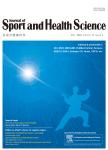Situational interest impacts college students’physical activity in a design-based bike exergame
Situational interest impacts college students’ physical activity in a design-based bike exergame作者机构:School of EducationUniversity of Bourgogne Franche-ComtéBesan¸con 25000France Teaching and Research Unit in Physical Education and SportUniversity of Teacher EducationLausanne 1014Switzerland
出 版 物:《Journal of Sport and Health Science》 (运动与健康科学(英文))
年 卷 期:2022年第11卷第2期
页 面:172-178,I0002页
核心收录:
学科分类:0403[教育学-体育学] 04[教育学] 1202[管理学-工商管理]
主 题:Active videogame College students Exergame Physical activity Situational interest
摘 要:Background:Active videogames or exergames have been used as an innovative way to promote physical activity(PA)among various populations.A player’s interest in active videogames is associated with the fun and entertaining nature of the games and may trigger situational interest,thus increasing engagement.The goal of this study was to examine the impact of situational interest dimensions on college students’PA when playing the design-based bike exergame Greedy Rabbit(Vescape,Berlin,Germany).Methods:Sixty undergraduate students(age:20.8±1.3 years,mean±SD,18-25 years old;51.7%males)were recruited from the kinesiology department of a university located in the southern region of Belgium.The participants were assigned to an experimental group(n=41)or a control group(n=19)based on an incremental cycling test.Students in the experimental group engaged in 1 session of Greedy Rabbit(Vescape)while students in the control group engaged in 1 session of a placebo version of Greedy Rabbit(Vescape).The length of the sessions ranged from 24 min to 31 min.Results:Results for the control group indicated that the players’PA metrics(cadence:F(19,360)=1.43,p=0.11;heart rate:F(19.360)=1.16,p=0.29;oxygen consumption:F(19,360)=0.83,p=0.67)were stable during the exergame.Results for the experimental group demonstrated the effects of time on the players’PA metrics and revealed significant associations between the change in the players’situational interest dimensions and PA metrics(cadence:F(19,800)=26.30,p0.01;heart rate:F(19,800)=19.77,p0.01;oxygen consumption:F(19,800)=10.04,p0.01).Conclusion:An approach using a design-based exergame may be a relevant strategy for promoting levels of PA that yields positive health-related outcomes among college students.



